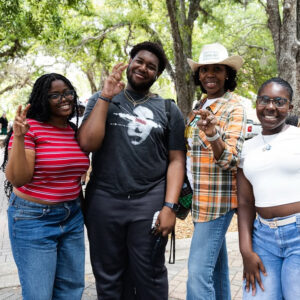Campus Life | March 7th, 2022
Here’s What Tallahassee Students Spend In A Week
By: Devani Allen

Budgeting as a college student can be difficult. With so many ways to spend money and fewer ways to make it, it is essential that students learn to balance their money. Whether students earn income from part-time jobs or their own business, these five students have both spending and saving in the bag each week.
First-year criminology student at Florida State University (FSU) Dakayla Demps is no stranger to saving money. Demps attend is a part of her university’s CARE program, a resource designated for first-generation college students.
“The only reason I go here is because of CARE,” said Demps. “They give us a stipend and that along with my private scholarships keeps my family from paying for anything.”
Despite not having to pay for much, the 18-year-old ensures that she has some sort of income. Demps works in the school library, for an average of 20 hours a week, as a part of work-study. The job opportunity pays $10 an hour.
View this post on Instagram
Due to her limited income, Demps makes certain she budgets her money to last her the entire month. Demps is from Miami and before attending FSU in the fall she worked at Chick Fil A, where she worked up to 35 hours a week making $11.25 an hour. Due to the substantial decrease in her income, the criminology student had to make minute changes in her lifestyle. On average Demps spends $50 to $100 weekly, but this week she spent over three times that amount.
Here’s the breakdown:
$210: Round trip plane ticket to Miami
$30: Starbucks coffee
$22: Organization fee
$15: Hygiene products
$40: Nail fill
Total: $317
Although the Miami native went over budget this week, she has no worries because money is always around. “I would say I’m in the middle of frivolous and nonchalant with my funds. If I want something I’m going to buy it because the money comes back, but I’m not a bad spender,” said Demps.
On top of saving her money for essentials, Demps credits her saving habits in college to Tallahassee being a boring town. “There’s not much to do here,” said Demps. “Tallahassee is really boring, and I don’t have that many friends so I kind of stay to myself.”
Unlike Demps, Myah Kemp, a second-year business student at Florida A&M University (FAMU) doesn’t have the privilege to work. Kemp travels home to Jacksonville, Fla., every summer to work and save money for the upcoming school year. Spreading her money throughout the school year hasn’t proven to be a problem yet.
“I utilize my checking and savings and am usually pretty good at spending and regulating what I do. I’m definitely not an impulsive spender,” said Kemp. “I spend most of my money on food or general maintenance like nails or a wax.”
View this post on Instagram
One thing she doesn’t have to worry about is the towering expense of hair products. Kemp transitioned her hair into locs last fall and hasn’t looked at a bottle of hair moisturizer since. “I usually use black soap for my hair because I have locs and mainstream products cause build-up,” said Kemp.
To save money and time, Kemp creates natural hair care products, such as oils and soap. “I want to start my own business surrounding natural products with shampoo, face washes and stuff like that. I make some now just for fun,” said Kemp. “When I was in high school, a lot of the people from my school used it and my family members said it worked good.”
Since food and maintenance are at the top of the Jacksonville native’s spending list, let’s look at her spending from last week.
Here’s the breakdown:
$6.55: Amazon prime subscription
$12.55: Waffle House
$6: McDonald’s
$5.56: Spotify
$6.94: Chick Fil A breakfast
$33.41: Publix groceries
$20.40: Gift for a friend
TOTAL: $91.41
Living on campus saves students like Kemp money in the long run. Whenever she’s hungry, all Kemp has to do is visit a dining location on campus. “When I spend money on outside food it’s a treat,” said Kemp. “I also have a mini-fridge, so it can only fit a small number of groceries.” On top of only buying a certain number of groceries, Kemp also visits Publix at certain times of the day and on certain days of the week, when she knows she’s bound to find a deal.
Not having to think about buying groceries is nice, until you live in an off-campus apartment. Leaha Stevens, a second-year biology pre-dental scholar at FAMU, says she spends about $250 on groceries monthly. “I try to limit my grocery store runs to once a month,” said Stevens. “I’m training for basketball right now so I eat at least 3 times a day.”
Amid basketball training and going to school, Stevens also works part-time at Steak n Shake. “I usually work between three and four days a week with 8-hour shifts, and my hourly wage is $12,” said Stevens. “I used to work at Chipotle, and I liked it because we received tips, but I had to leave because the FSU customers were too much to deal with.”
Even though the pay at her current job suffices, Stevens doesn’t plan on staying much longer. “I’m trying to focus more on school, that’s my top priority,” said Stevens. “I try to schedule set days to do my homework on off days or try and get it in before work.”
This week, Stevens spent almost $300, two times more than what she averages.
$60: Walmart
$30: Savings
$145: Towing company
$10: Lyft
$33: Food
$15: Haircut
TOTAL: $293
Stevens’ mother pays for her rent and utilities, so the future dentist can focus on her studies.
While some students have no choice but to work, for students like third-year FAMU softball player, Jania Davis, their parents won’t allow it. “I tried to convince my parents to allow me to work, but they refused to let that happen,” said Davis. “I’m only available to work two months out of the year and that’s during the summer.”
View this post on Instagram
So, how does Davis manage to have money? The business administration student, like many others, uses her refund check from the school to buy the things she needs. “I get a refund check from the school and manage that,” said Davis. “On top of that, I have long periods where I put myself on a very strict budget.”
Budgeting hasn’t always come easy to Davis. As a child, the softball player spent money constantly. “Growing up I used to spend money like it was nothing because it was my parent’s money,” said Davis. “When I started working and making my own money, I became very frugal.”
Davis describes her spending habits as the middle of the road. “I have periods when I can be irresponsible and buy things impulsively,” said Davis. “Most of the time it’s a 60:40 ratio, 60% frugal, 40% frequent spending.”
This week, Davis spent just over $200:
– $15: Beauty products
– $35: Clubbing
– $25: Gas
– $50: Groceries
– $93: Fast food
TOTAL: $218
Senior nursing student Jabari McCarthy allocates most of his money towards bills. McCarthy is a bartender and relies on his tips to sustain his spending. “I have a lot of responsibilities, such as helping out with my little sister, so not working isn’t an option for me,” McCarthy said, who attends a private nursing student. “I get paid $7.25 an hour plus tips which average $250 to $300 depending on how busy the restaurant is.”
View this post on Instagram
The bartender hasn’t always had to be responsible with money. For a while, McCarthy didn’t work and focused solely on school. After realizing how much nursing school would cost, McCarthy buckled down and hasn’t looked back since. “I don’t have a lot of free time outside of school and work,” said McCarthy. “When I do get off days I try to relax as much as possible because nursing school can get stressful.”
Staying at home does help the nursing student cut living costs. “Sometimes I wish I went to school far away just to get the full college experience, but I think everything happens for a reason, ” said McCarthy. “Being at home has helped me save money for new things like hiring a personal trainer.”
Hiring a personal trainer isn’t the only thing McCarthy spends his money on.
Here’s the breakdown:
– $30: Food
– $40: Gas
– $20: Haircut
– $100: Savings
– $50: Clothing
TOTAL: $240
If it’s one thing college students have mastered, it’s spending money. From $30 at Starbucks to $50 on clothes, these students at least have spending in control.





